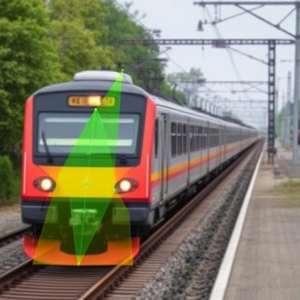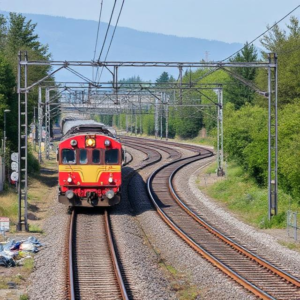A Train Positioning System (TPS) is a technology used to track the exact location of a train on a railway track in real-time. It ensures that the train is running on the correct route and helps improve safety, efficiency, and coordination between trains and control centers. Let me explain it in simple terms:
1. What is a Train Positioning System (TPS)?
- A Train Positioning System (TPS) is a system that tracks the position of a train as it moves along the railway track. It uses different technologies, like GPS, sensors, and communication systems, to determine and report the train’s location to the control center or onboard systems.
- This system helps railway operators manage train movements, prevent accidents, and ensure that trains follow their scheduled routes.

2. How Does a Train Positioning System Work?
There are several ways a TPS can determine a train’s position, and often, it uses a combination of technologies:
- GPS (Global Positioning System):
- Many modern trains are equipped with GPS receivers. GPS uses signals from satellites to calculate the exact location of the train on the Earth’s surface.
- The GPS continuously updates the train’s position and sends this data to the control center, where operators can track the train’s progress in real-time.
- GPS is especially useful for long-distance trains running across vast areas because it provides precise location data anywhere with a clear view of the sky.
- Trackside Sensors:
- Along the railway tracks, there are sensors installed that detect when a train passes by. These sensors can identify the position of the train and send this information to the control center.
- These sensors are often used in addition to GPS to improve accuracy, especially in areas where GPS signals may not be as strong, such as in tunnels or dense urban areas.
- Odometry:
- Some systems use odometry, which calculates the train’s position based on the distance it has traveled from a known starting point. It uses the movement of the train’s wheels to measure how far it has gone.
- This method helps in areas where GPS signals are weak or blocked but needs to be corrected periodically with other positioning methods to avoid errors over time.
- Radio Frequency (RF) and Beacons:
- In some railway networks, special beacons or RFID (Radio Frequency Identification) tags are installed along the tracks. These beacons send signals to onboard receivers, providing the exact position of the train.
- The beacons are often placed at fixed intervals on the tracks, and the onboard system calculates the train’s position by detecting which beacon the train is near.
- Communication-Based Train Control (CBTC):
- Some modern railways use CBTC systems, which involve a continuous exchange of data between the train and control center. CBTC uses a combination of sensors, signals, and onboard communication systems to monitor and control the train’s position.
- This system can also adjust the train’s speed and routing to improve efficiency and safety, especially in busy urban areas.
3. Why is a Train Positioning System Important?
- Safety: TPS helps prevent accidents by ensuring that trains do not get too close to each other. It provides real-time data to control centers, so operators can take action if a train is off-track, going too fast, or nearing another train.
- Efficiency: By knowing exactly where every train is, railway operators can adjust schedules, manage train traffic, and avoid delays. It helps in improving the overall flow of train operations, especially in busy areas with lots of trains.
- Automatic Train Control (ATC): TPS is crucial for systems like Positive Train Control (PTC) or Automatic Train Operation (ATO), which are safety systems that automatically control the speed and position of a train to prevent accidents.
- Better Passenger Experience: With accurate train position data, passengers can receive real-time updates on train arrival times, delays, and other information, improving their travel experience.
- Maintenance and Monitoring: The system can also track the health of trains and their components, sending alerts when maintenance is needed, and ensuring that the trains are always in good condition.
4. How is TPS Used in Different Scenarios?
- Long-Distance and High-Speed Trains: For trains traveling across large distances, TPS is essential for continuous tracking. GPS is often the primary method, giving accurate location information in real-time, even when the train is far from stations or cities.
- Urban and Metro Systems: In urban railway systems, like metros, TPS uses a combination of trackside sensors and communication systems (like CBTC). This helps manage train positions closely in areas where trains run at high frequency and in confined spaces like tunnels.
- Freight Trains: Freight trains, which often travel at slower speeds and over longer routes, also rely on TPS for tracking. This ensures that the train is on the correct track and helps with scheduling, as freight trains are often managed around passenger trains.
- Emergency Situations: In case of an emergency or breakdown, knowing the exact position of a train helps emergency services respond faster. It also allows control centers to reroute other trains and minimize disruptions.
5. Benefits of Train Positioning Systems:
- Improved Safety: Continuous monitoring of train position prevents accidents, reduces the risk of collisions, and allows for quicker response in emergencies.
- Real-Time Tracking: It provides up-to-the-minute data about where a train is, improving scheduling, reducing delays, and enabling efficient traffic management.
- Better Coordination: It allows better coordination between trains, especially when managing multiple trains on the same route or busy tracks.
- Predictive Maintenance: With continuous monitoring, the system can detect issues with the train (such as mechanical failures) early, allowing for preventative maintenance.
- Passenger Satisfaction: Real-time position updates allow passengers to be informed about their train’s location and expected arrival times.
6. Challenges of Train Positioning Systems:
- Cost and Installation: Installing a comprehensive TPS across a large railway network can be expensive and time-consuming.
- Accuracy in Complex Areas: GPS signals might not work well in tunnels or in areas with a lot of tall buildings. To overcome this, other technologies like sensors and trackside equipment are used, but they can also face limitations.
- Data Overload: TPS generates a lot of data that needs to be processed quickly. Railway systems need powerful systems to analyze and manage all the data in real-time.
Conclusion:
A Train Positioning System (TPS) is essential for modern railways, ensuring safe, efficient, and coordinated train operations. By using technologies like GPS, sensors, and communication systems, TPS helps track the exact location of trains, preventing accidents, improving schedules, and keeping passengers informed. It’s a key technology for managing both high-speed trains and urban metro systems, and it plays a vital role in making rail travel safer and more efficient.
Keywords: Train Positioning System (TPS), Railway











